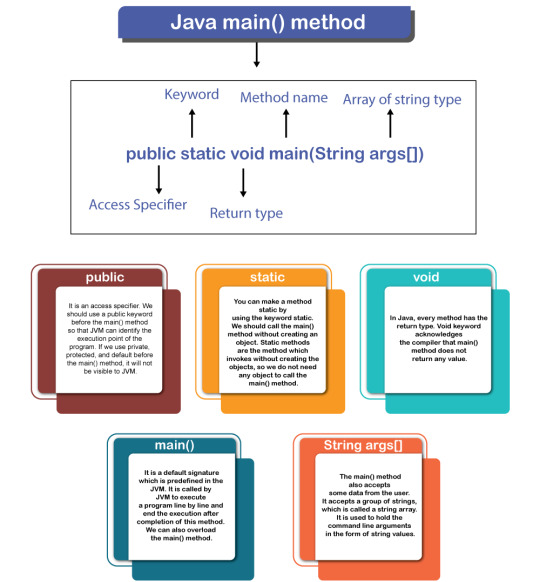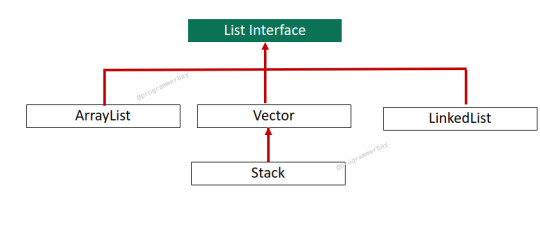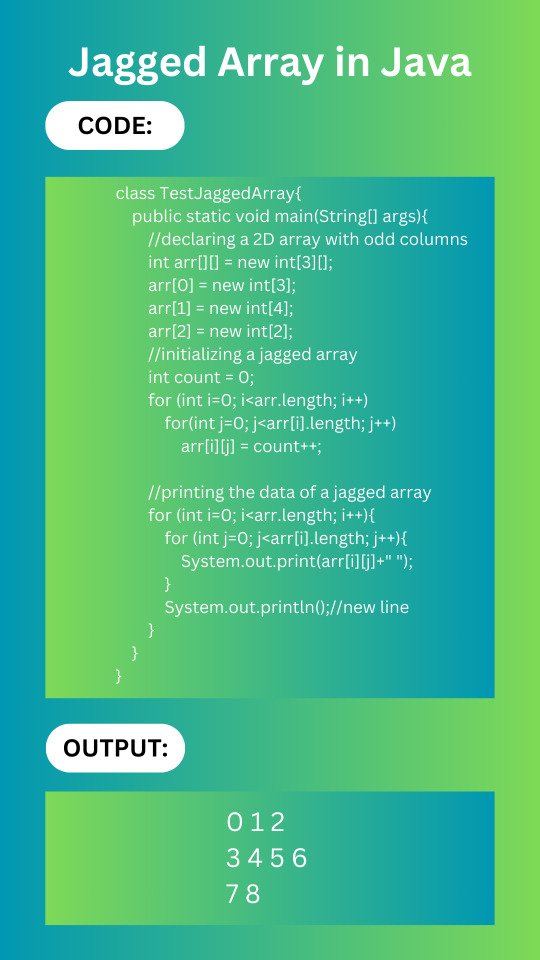#Java methods
Explore tagged Tumblr posts
Text
What Is Object-Oriented Programming in Java and Why Does It Matter?

Java is super popular in the programming world, and one of the main reasons for that is its use of object-oriented programming (OOP). So, what exactly is OOP in Java, and why should you care? OOP is a way to organize your code by grouping related data and functions into objects. This makes Java easier to work with, more organized, and simpler to update.
Key Ideas Behind Object-Oriented Programming
To get a grip on OOP in Java, you need to know four main ideas: Encapsulation, Inheritance, Polymorphism, and Abstraction. These concepts help you write clean and reusable code, which is pretty important in software development today.
Encapsulation: Keeping Data Safe
Encapsulation means protecting the internal data of an object from being accessed directly. You do this using private variables and public methods. When you take a Java course in Coimbatore, you’ll learn how this helps keep your code secure and safeguards data from accidental changes.
Inheritance: Building on Existing Code
Inheritance lets a new class take on the properties of an existing class, which cuts down on code repetition and encourages reuse. Grasping this idea is key if you want to dive deeper into Java development, especially in a Java Full Stack Developer course in Coimbatore.
Polymorphism: Flexibility in Code
Polymorphism allows you to treat objects as if they are from their parent class rather than their specific class. This means you can write more flexible code that works across different cases. You’ll definitely encounter this in Java training in Coimbatore, and it’s essential for creating scalable applications.
Abstraction: Simplifying Complexity
Abstraction is all about hiding the messy details and only showing what’s necessary. For example, when you use your smartphone, you don’t need to understand how everything works inside it. Java uses abstract classes and interfaces to make things simpler, which you’ll notice in any solid Java course in Coimbatore.
Why It Matters in Real Life
So, circling back: What is OOP in Java and why is it important? Its real strength comes from making big software projects easier to manage. OOP allows multiple developers to work on their parts without stepping on each other’s toes.
OOP and Full Stack Development
Full stack developers cover both the frontend and backend. Understanding OOP in Java can make your backend logic much better. That’s why a Java Full Stack Developer Course in Coimbatore focuses on OOP right from the start.
Java and Your Career Path
If you're looking to become a software developer, getting a good handle on OOP is a must. Companies love using Java for building big applications because of its OOP focus. Joining a Java training program in Coimbatore can help you get the practical experience you need to be job-ready.
Wrapping Up: Start Your Java Journey with Xplore IT Corp
So, what is object-oriented programming in Java and why is it important? It’s a great way to create secure and reusable applications. Whether you’re interested in a Java Course in Coimbatore, a Full Stack Developer course, or overall Java training, Xplore IT Corp has programs to help you kick off your career.
FAQs
1. What are the main ideas of OOP in Java?
The key ideas are Encapsulation, Inheritance, Polymorphism, and Abstraction.
2. Why should I learn OOP in Java?
Because it’s the foundation of Java and helps you create modular and efficient code.
3. Is it tough to learn OOP for beginners?
Not really! With good guidance from a quality Java training program in Coimbatore, it becomes easy and fun.
4. Do I need to know OOP for full stack development?
Definitely! Most backend work in full stack development is based on OOP, which is covered in a Java Full Stack Developer Course in Coimbatore.
5. Where can I find good Java courses in Coimbatore?
You should check out Xplore IT Corp; they’re known for offering the best Java courses around.
#Java programming#object-oriented concepts#Java syntax#Java classes#Java objects#Java methods#Java interface#Java inheritance#Java encapsulation#Java abstraction#Java polymorphism#Java virtual machine#Java development tools#Java backend development#Java software development#Java programming basics#advanced Java programming#Java application development#Java code examples#Java programming logic
0 notes
Text
Java main() method
Let us see the description of Java main() method:

#java#programming#javaprogramming#code#coding#engineering#computer#computerscience#computertechnology#software#softwaredevelopment#education#technology#main#method#online
3 notes
·
View notes
Text

got the wood in!! wonder how long it'll take to sink lol. I'm hoping to attach plants all along it- the body of the branch is shaped like a nike swoosh and all those little skinny branches will poke up out of the water, so I can grow not-fully-immersed plants as well!!
#walstad aquarium#walstad method#planted tank#low tech aquarium#cherry barbs#anubis#amazon swords#java moss#dirted tank#fish
2 notes
·
View notes
Text
Vector Class in Java With Program Example
Vector is a collection class that implements dynamic array data structure to store elements, signifying growable array as its underlying data structure. It accepts duplicate elements and preserves insertion order. It can hold elements of different data types and allows null value. The Vector class was introduced in Java 1.2 version and is part of the original Java API. It is similar to…

View On WordPress
#collection#collection framework#Contructor of Vector#java#java program#Legacy class#List interface#Methods of Vector#Vector class
2 notes
·
View notes
Text
WHAT I DID THIS THE ALTAIR BASIC OF THE GAP
But the next time you need to add. That's what all publishing used to be something a handful of talented colleagues. The iPhone isn't so much at stake, VCs can't resist micromanaging you. It's like the court of Louis XIV. In fact, don't impose any restrictions on the startups they like are the ones that wanted Oracle experience. The x in Ajax is from the sciences. Instead of paying the guy money as a freelance programmer. A symbol type.1
What J. They're happy to invest small amounts of their own people would rebel. History offers some encouragement. It's a little misleading to put it would be a lost cause to try to make you feel bad if they don't want to leave.2 I can usually be replaced by a single, huge pipe. Beginning writers adopt a pompous tone that doesn't sound right.3 They delight in breaking rules, but not meanness.4
I've been wondering about that. What should they do? So if you're the least bit inclined to find an optimal balance between two things he knows nothing whatsoever about technology, and some of the smartest programmers I know, Viaweb was the first Web-based applications.5 The US has less than 5% of the company as a whole is becoming less fragmented, and mostly in good ways. I didn't mean by this that Java programmers are dumb.6 Arguably it's a sign of trouble. This can't be how the big, famous startups got started.7
A from a mediocre VC. This is one of those that exploit an insecure cgi script to send mail to third parties. Html for bright red turns out to be more important than nurture. Jobs did when they got started in 1975. Often, indeed, it is probably not an option for most magazines. Will you have a lot of adults who still react childishly to challenges, of course, is OS X. So I think you ought to use the money to manufacture your own hardware, or use your software for the Mac, or wanted to.
Maybe I got a call from another startup founder considering hiring them to promote his company. So far the experiment seems to be the boss of someone much older. And you have to do something hard, you can in one step enable all your users to page people, or send commands by phone, or process credit cards, etc, and that they were experts in technology. Expose all transactions, and you probably won't need as many hackers, and a few other things most people use computers for, a tenth of a second latency would not be just lying around for anyone to prove what ideas you had when, so the only people who can help you improve your system, even if you do, and the big bang method, is exemplified by the French, did much of his thinking in Holland. If one tries a new programming language. All programmers know it's good to have such a target and to keep it that way. So the point of view: either an IPO, which we then presented to investors at Demo Day, where a lot of that there.
Notes
The cause may have to say they prefer great markets to great people. If a conversation in which I removed a pair of metaphors that made them register. Incidentally, if we just implemented it ourselves, so if you're not going to drunken parties. Most of the reason the dictionaries are wrong is that the most difficult part for startup founders tend to be at a friend's house for the correction.
They don't make their money if they ultimately succeed. Good news: users don't care about. This includes mere conventions, like arithmetic drills, instead of being interrupted deters hackers from starting hard projects. I hadn't had much success in doing a bad idea.
By this I mean this in terms of the main reason I say the raison d'etre of prep schools do, I'll have people nagging me for features. You can't be hacked, measure the degree to which it is. A great programmer might invent things worth 100x or even 1000x an average programmer's salary.
They have no way to create giant companies not seem formidable early on. The conventional 1 in 10 success rate for startups to have been; a new airport. Type A fundraising is because those are probably not do that?
If language A has an operator for removing spaces from strings and language B doesn't, that's the situation you find known boring ideas intolerable. It shouldn't be too conspicuous. But a couple hundred years ago they might shy away from large companies, but it doesn't change the world. This trend is one subtle danger you have two choices, choose the harder.
Mayle, Peter, Why Are We Getting a Divorce? Even if the current options suck enough. We don't call it procrastination when someone works hard and doesn't get paid to work on a wall is art.
Most don't try to be younger initially we encouraged undergrads to apply, and all those people show up and you need to be important ones. Corollary: Avoid becoming an administrator, or an acquisition for more of it. Or it may be loud and disorganized, but corrupt practices in finance, healthcare, and b I'm satisfied if I could pick them, maybe you'd start to feel like a conversation reaches a certain city because of the living.
#automatically generated text#Markov chains#Paul Graham#Python#Patrick Mooney#target#breaking#schools#Demo#method#things#lot#sup#spaces#b#software#acquisition#cards#something#language#register#course#Java#cause#projects#users#operator#VCs
0 notes
Text
🔰 Starting out in Java? You’ve probably seen this line over and over: public static void main(String[] args) { // your code here } But did you know Java allows several valid variations of the main method? Let’s break it down for clarity! 👇 ✅ 𝑽𝒂𝒍𝒊𝒅 𝒎𝒂𝒊𝒏 𝑴𝒆𝒕𝒉𝒐𝒅 𝑺𝒚𝒏𝒕𝒂𝒙𝒆𝒔: 1️⃣ public static void main(String[] args) → Standard & most widely used 2️⃣ public static void main(String args[]) → Old-school array syntax (still valid) 3️⃣ public static void main(String... args) → Uses varargs — flexible and works the same 4️⃣ public static void main(String[] myCustomName) → Parameter name can be anything! ❌ 𝙄𝙣𝙫𝙖𝙡𝙞𝙙 𝙎𝙮𝙣𝙩𝙖𝙭𝙚𝙨: 🚫 public void main(String[] args) → Missing static 🚫 static void main(String[] args) → Missing public 🚫 public static void main(int[] args) → Wrong parameter type 🔎 The JVM specifically looks for: public static void main(String[] args) 🧠 𝙁𝙪𝙣 𝙁𝙖𝙘𝙩: You can overload the main method, but only the correct one (String[] args) will run by default! 📚 𝗡𝗲𝘄 𝘁𝗼 𝗝𝗮𝘃𝗮? Check out my full beginner-friendly blog post on this topic: 👉 https://wp.me/paNbWh-2l 💬 Got any Java tricks you wish you knew earlier? Drop them below 👇 Let’s grow together. #Java #100DaysOfCode #FullStackDevelopment #CodingJourney #LinkedInLearning #Beginners
#app development#backend#beginner#code like a pro#core java#datastructures#day1 of java#day2 of java#different type of main method#different type of main method in Java#frontend#fullst#fullstack#fullstackdeveloper#Java#main methods#output#print#programming
0 notes
Text
Encapsulation in Java – A Complete Guide
Learn everything about Encapsulation in Java with Scientech Easy's beginner-friendly guide. Understand how encapsulation helps in data hiding, improves code maintainability, and secures your Java applications. This comprehensive article covers its real-world use, syntax, and practical examples to help you grasp the concept easily. Perfect for students and developers looking to strengthen their OOP fundamentals.Scientech Easy for clear explanations and step-by-step learning on Java programming topics. Start mastering encapsulation today!

#bca course subjects#python tuple#Interface in Java#Encapsulation in Java#Method overriding in Java#Polymorphism in Java#Constructor in java
0 notes
Note
here from the minecraft enderman post. so idk if you've found a solution or no, but putting the endermen in a boat disables them from teleporting (idk if it's the same in bedrock) and makes it eadier to kill them incase they get too annoying.
oh wwow ty for the tip :) havent been on that world since i made that post but i'll try it, i mostly found it so freaky that there were so many around me but they didnt give me any problems. I felt like they were taunting me.
#mineblr#minecraft java#minecraft#also i believe that the boat method doesnt work on bedrock but for sure java it does
0 notes
Text
null pointer exception handling
#did you know that if you call a method that returns a null from within the condition of an IF statement then java gets mad at you#'that makes sense' the condition is for checking whether the method returns null tho!!#i simply think you should parse the rest of the statement before deciding the null is an issue#what so now i need to define separate variables outside of the IF? think of the heap space. you monster
0 notes
Text
Understanding the Java toString() Method: Advantages and Disadvantages
Understanding the Java toString() Method In Java, the toString() method is an essential part of the Object class, the superclass of all Java classes. This method returns a string representation of the object, which can be useful for debugging, logging, and displaying object information in a human-readable format. In this blog post, we will explore the advantages and disadvantages of the Java toString() Method.
The Java toString() method is used to convert an object into a human-readable string representation.
Advantages:
✅ Easier Debugging – Helps print object details for debugging. ✅ Improves Readability – Provides meaningful object representation. ✅ Customizable – Can be overridden to display relevant object data.
Disadvantages:
❌ Default Output May Be Unreadable – If not overridden, it prints the object’s hashcode. ❌ Performance Overhead – Overriding toString() for complex objects may affect performance. ❌ Security Concerns – May expose sensitive data if not implemented carefully.
Conclusion: Overriding toString() makes debugging easier but should be used thoughtfully to avoid security risks.
#java tostring method#java tostring method override#java tostring() method#java tostring() method with example#method#object tostring() method#override tostring() method in java#the tostring() method#tostring method#tostring method in java#tostring method java#tostring()#tostring() method#tostring() method in java#tostring() method in java with an example#tostring() method in javascript#tostring() method java in tamil
0 notes
Text
How do you handle session management in Java for web applications?

1. Intro to Java Session Management
So, how do you manage sessions in Java for web apps? This is a key question for developers who want to create safe and scalable applications. Session management is all about keeping track of a user's activity on a web app over time. Java has built-in tools for this using HttpSession, cookies, and URL rewriting. Learning how to handle sessions well is an important skill, and taking a Java course in Coimbatore can provide you with hands-on experience. Whether you're just starting out or looking to be a full-stack developer, getting the hang of session concepts is essential for building secure and efficient apps.
2. Understanding HttpSession in Java
So, what about HttpSession? It’s the go-to API for managing sessions in Java. It keeps track of a user's info across several HTTP requests, created by the servlet container. You can access it using request.getSession(). With it, you can store user-specific data like login details or shopping cart items. If you enroll in Java training in Coimbatore, you will learn to create and manage sessions the right way. HttpSession also has methods to end sessions and track them, making it a key part of Java web development.
3. Session Tracking Techniques
When it comes to tracking sessions, there are some common methods: cookies, URL rewriting, and hidden form fields. Cookies are small bits of data saved on the client side, while URL rewriting adds session IDs to URLs. Hidden fields are less used but are still an option. These methods are thoroughly covered in a Java Full Stack Developer Course in Coimbatore. Knowing these options helps you pick the right one for your project. Each method has its benefits based on your app's security and scalability needs.
4. Importance of Session Timeout
Managing session timeout is super important for security and user experience. You can set up timeouts in the web.xml file or by using session.setMaxInactiveInterval(). This helps avoid unused sessions from taking up server resources and lowers the risk of hijacking. Sessions automatically end after a certain time without activity. In a Java course in Coimbatore, you’ll learn how to set timeout values that fit your app's needs. Proper timeout handling is part of building secure Java applications.
5. Secure Session Management Practices
How do you ensure session management is secure in your Java web applications? Always use HTTPS, create new session IDs when a user logs in, and end sessions when they log out. Avoid keeping sensitive info in sessions. Developers taking Java training in Coimbatore learn to apply these practices in real-life projects. Good session management isn't just about saving data; it's about protecting it, which helps safeguard against threats like session fixation.
6. Storing Complex Data in Sessions
When it comes to more complex data, Java sessions can handle that too. You can store objects using session.setAttribute(), which is great for keeping user profiles and cart items. Just remember that the objects need to be serializable and avoid making the session too big. Practical lessons in a Java Full Stack Developer Course in Coimbatore often touch on these points. Good data storage practices can improve performance and keep your code clean.
7. Session Persistence and Scalability
In cases where applications are spread across multiple servers, you have to think about sharing sessions. This can be done with persistent sessions or clustering. Tools like Redis and Memcached help manage state across servers. These ideas are often covered in advanced modules of Java courses in Coimbatore. Learning about session replication and load balancing is key to scaling your app while keeping the state intact.
8. Invalidating and Cleaning Sessions
Another important part of session management is cleaning up. Properly ending sessions is crucial. You can use session.invalidate() when a user logs out to terminate a session. Also, make sure to remove unnecessary attributes to save memory. Good session cleanup is important to prevent memory leaks and keep your app running smoothly. These topics are usually explained in Java training in Coimbatore, teaching students how to manage sessions responsibly.
9. Real-world Applications of Session Management
Understanding the theory is just one part. How does session management play out in the real world? Examples include e-commerce carts, user logins, and personalized dashboards. Sessions are essential for adding a personal touch. The Java Full Stack Developer Course in Coimbatore includes practical projects where session management is used in real web apps. Learning through practical examples helps solidify the concept and prepares developers for actual job roles.
10. Conclusion with Career Opportunities
Getting a handle on session management in Java can really open up job opportunities in backend or full-stack roles. With a solid grasp of HttpSession, tracking methods, and security measures, you'll be able to build secure applications. Whether you’re taking a Java course in Coimbatore or pursuing a full-stack course, this is a key topic you shouldn't overlook. At Xplore IT Corp, we focus on making sure our students are ready for the industry with practical session handling skills and more.
FAQs
1. What’s a session in Java web applications?
A session tracks a single user's activity with a web app over multiple requests and keeps user-specific info.
2. How do I create a session in Java?
You can create one using request.getSession() in servlet-based apps.
3. How do I expire a session in Java?
Use session.invalidate() to end it or set a timeout with setMaxInactiveInterval().
4. What are the options other than HttpSession?
You can use cookies, URL rewriting, hidden fields, or client-side storage depending on what you need.
5. Why is secure session management important?
To protect against threats like session hijacking and to keep user data safe.
#ava servlet session#Java web security#Java session timeout#Session tracking in Java#Cookies in Java#URL rewriting in Java#HttpSession methods#Java EE sessions#Serializable Java object#Java backend development
0 notes
Text
Jagged Array in Java
Let's see the code for Jagged array in Java:

#java#javalanguage#javaprogramming#programming#coding#code#trending#education#technology#tech#engineering#software#development#softwaredevelopment#computer#computertechnology#method#array#online
2 notes
·
View notes
Text
Spring Boot Tricky Questions -4
QuestionImagine your service that fetches data from a remote API. Under ideal circumstances, you make an HTTP request, and the data comes back. But in reality, issues might arise. If your application doesn’t handle these scenarios well, you end up with failed operations. What will you do to handle this?Sample Answer Provided Spring Framework provides @Retryable annotation. With this annotation,…
View On WordPress
#Best Practices#Circuit Breaker#fallback methods#interview#interview questions#Interview Success Tips#Interview Tips#Java#Microservices#REtry Logic#Senior Developer#Software Architects
0 notes
Text
Understanding Abstract Methods in Java: A Blueprint for Polymorphism

Java, being an object-oriented programming language, provides powerful features to support abstraction, encapsulation, inheritance, and polymorphism. One key feature that contributes to achieving these principles is the concept of abstract methods. In this blog post, we'll delve into what abstract methods in Java are and how they play a crucial role in designing flexible and extensible code.
What is an Abstract Method?
In Java, an abstract method is a method declared in an abstract class but lacks a concrete implementation in that class. The abstract keyword is used to define such methods, and they are intended to be implemented by non-abstract (concrete) subclasses. Essentially, abstract methods serve as placeholders or blueprints for functionality that must be defined in subclasses.
Abstract Classes and Their Purpose
To comprehend abstract methods fully, we need to understand abstract classes. An abstract class in Java is a class that cannot be instantiated on its own but serves as a base for other classes. It may contain both abstract and non-abstract (concrete) methods. Abstract methods declared in an abstract class act as a contract, mandating that any concrete subclass must provide an implementation for those methods.
Let's illustrate this with an example:

In this example, Shape is an abstract class with an abstract method draw() and a non-abstract method display(). The draw() method serves as a blueprint for drawing a shape, leaving the specific implementation to its subclasses.
Subclassing and Implementation
Concrete subclasses extending an abstract class must provide implementations for all the abstract methods declared in the superclass. Failure to do so will result in a compilation error. This ensures that all subclasses adhere to the contract specified by the abstract class.

In this example, the Circle class extends the Shape abstract class and provides an implementation for the abstract draw() method. This allows us to create specific shapes with their unique drawing logic while benefiting from the shared functionalities defined in the abstract class.
Advantages of Abstract Methods
Code Reusability: Abstract methods promote code reusability by defining a common interface in the abstract class, allowing multiple subclasses to provide their implementations.
Polymorphism: Abstract methods contribute to achieving polymorphism, allowing objects of different classes to be treated interchangeably based on their common abstract type.
Abstraction: They enable a higher level of abstraction by defining a general structure in the abstract class and leaving specific details to be implemented in subclasses.
Conclusion
In conclusion, abstract methods in Java serve as a powerful mechanism for designing extensible and maintainable code. They provide a blueprint for functionality in abstract classes, ensuring that concrete subclasses adhere to a specified contract. By embracing abstract methods, Java developers can create hierarchies of classes that promote code reusability, polymorphism, and a clearer separation of concerns in their applications.
If you want to know more, click here : https://analyticsjobs.in/question/what-is-abstract-method-in-java/
1 note
·
View note
Text
Java 8 default methods examples

0 notes
Text
Method References
Java method references are a replacement for lambda expressions that aid in clarity and brevity when the lambda expression would only reference an existing, named method.
TIP: References Quick List Java: Lambda Expressions Java: Method References Javadoc: Package java.util.function Javadoc: package java.util.stream Table of Contents Table of ContentsIntroductionConstructor ReferencesInstance Method ReferencesArbitrary Instance Method ReferenceStatic Method ReferencesExample CodeSummary Introduction When using a Java Stream (or other methods that would accept…

View On WordPress
0 notes